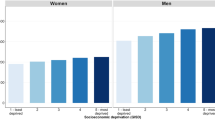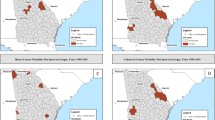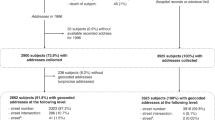Abstract
Using birth addresses, we examined the geographical variation in risk for all types of childhood cancers in the UK, on a scale corresponding to the 10-km squares of the National Grid. The effects of socioeconomic and environmental factors, including natural background radiation, were investigated and their relative importance assessed using Poisson regression. Data came from a national collection of all fatal cancers between 1953 and 1980 in children aged 0-15 years and consisted of 9363 children of known place of birth from 12 complete annual cohorts born in the period 1953-64. For solid cancers, as well as for leukaemias and lymphomas, there was marked variation of cumulative mortality according to place of birth. High mortalities were associated with areas characterized as having high social class, higher incomes and good housing conditions, but also with high population densities (births per hectare). Each of these contrasting social indicators operated independently of the other, indicating complex determining mechanisms. Mortalities increased with increased radon exposure, and the relationship operated independently of the socioeconomic factors. At this scale of analysis, we found no increased mortality in industrialized areas. A population-mixing infective hypothesis, which postulates high rates of leukaemia when highly exposed urban populations are introduced to isolated rural areas, was supported by observations of high mortalities in 'growth areas' and New Towns, but was not readily reconcilable with the high rates seen in the high-density areas. If these correlations do indeed represent an infective mechanism, then the outcomes are not limited to malignancies of the immune system alone.
This is a preview of subscription content, access via your institution
Access options
Subscribe to this journal
Receive 24 print issues and online access
$259.00 per year
only $10.79 per issue
Buy this article
- Purchase on Springer Link
- Instant access to full article PDF
Prices may be subject to local taxes which are calculated during checkout
Similar content being viewed by others
Author information
Authors and Affiliations
Rights and permissions
About this article
Cite this article
Gilman, E., Knox, E. Geographical distribution of birth places of children with cancer in the UK. Br J Cancer 77, 842–849 (1998). https://doi.org/10.1038/bjc.1998.137
Issue Date:
DOI: https://doi.org/10.1038/bjc.1998.137
This article is cited by
-
Spatial clustering of childhood cancers in Switzerland: a nationwide study
Cancer Causes & Control (2018)
-
Residential mobility and risk of childhood acute lymphoblastic leukaemia: an ecological study
British Journal of Cancer (2007)
-
Urbanisation and incidence of acute lymphocytic leukaemia among United States children aged 0–4
British Journal of Cancer (2005)
-
The cancer epidemiology of radiation
Oncogene (2004)
-
The United Kingdom Childhood Cancer Study of exposure to domestic sources of ionising radiation: 1: radon gas
British Journal of Cancer (2002)



